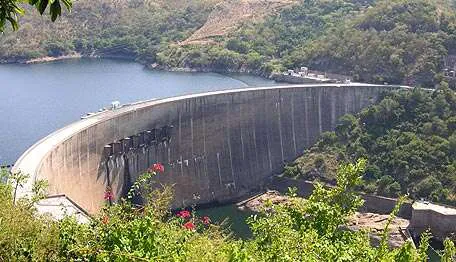The hydroelectric plants can no longer run, because there is no longer enough water in Lake Kariba due to the drought in Africa. Due to the energy crisis caused by the drought, Zambia is currently experiencing the country’s worst power outages in human memory, reports include Euro News.
Kariba is the world’s largest man-made lake by volume. It is located 200 kilometers south of the country’s capital, Lusaka, right on the border between Zambia and Zimbabwe.
The artificial lake is 220 kilometers long, on average 30 meters deep and has a volume of about 185 cubic kilometers.
The massive dam wall was built in the 1950s, when more than 80 workers died during construction. The water of the Zambesi River was captured, turning the valley into a huge lake. The dam was meant to revolutionize energy production in Zambia and Zimbabwe by providing an endless source of renewable hydropower.
However, this is no longer the case. The months-long droughts caused by the natural El Niño weather phenomenon and exacerbated by climate change have brought the hydroelectric power plant to the brink of being completely shut down for the first time.
The 128 meter high wall of the dam is almost completely exposed.
Usually, the lake level rises about six meters after the rainy season. According to the authorities, after the last rains, the water level rose only less than 30 centimeters.
We are hoping for good rains this year, which should start in November. However, according to estimates, it will take three more rainy years for the hydropower capacity to fully recover.
An emergency is in progress
In March 2024, Zambia declared a state of emergency due to prolonged drought.
“This drought has devastating consequences for many sectors, such as agriculture, water availability and energy production, endangering our national food security and the livelihoods of millions of people,” the country’s president Hakainde Hichilema uttered.
The water level is so low that only one of the six turbines on the Zambian side of the dam can operate. This drops the power plant’s production to less than ten percent of normal capacity.
“The electricity crisis is a bigger blow to the economy and the fight against poverty than the lockdowns during the covid-19 pandemic”, President of the Zambia Manufacturers Association Ashu Sagar says.
Hydropower covered more than 80 percent of the country’s electricity needs. Now citizens only get electricity for a few hours a day. Other areas are without electricity for several days at a time.
The Zambian government has urged residents and businesses to utilize solar energy, but many cannot afford to purchase panels.
The government itself has resorted to the more familiar but polluting diesel generators for the temporary energy production of hospitals and other buildings. The government has also announced that it will increase the production of coal-fired power plants when necessary.
In the neighboring country Zimbabwe, a large part of the electricity production of the Karibajärvi dam has also been lost, and power outages are common there as well. However, the state gets a larger part of its electricity from coal-fired power plants.

Tiara4D: Kunci Sukses Anda dalam Judi Slot Online – michellesellslv
404 Not Found
404 Not Found
Lice Busters Videos | ReverbNation
karanmanley – Utilizadores – CascaisData
lincolnrioux · Profile · Disqus
braddavison's Profile | CTS Connects
The Value of Professional Cleaning Services for Homes and Businesses
Arden's Garden Juice Bar & Smoothies Stone Mountain – Post Free Classified Ads
radishglue3的空間 – Android 台灣中文網 – APK.TW
Page not found – Social Media Service to Submit Top News, Videos and Images
Page not found – Most Popular Social Bookmarking Site to Boost SEO Content
lorenadoyle | ReverbNation
User Profile for sybleguidry
Certificate verification problem detected
Selami Perjudian Slot Online dengan Tiara4D – cryptoesus
Guia para Iniciantes em Vaping: A Maneira Fácil de Fazer a Mudança Tickets, October 16, 2024 12:02 PM | Metooo
프로필 – vaporplanetpt
caitlynham
@russellkorner on Tumblr
crestalink0 Publisher Publications – Issuu
Certificate verification problem detected
tracimckay tracimckay's Profile page
Ovogg: Agen Togel Terbaik Untuk Kemenangan Maxwin Yang …
http://www.moe.gov.sa
Jelajahi Adamslot: Destinasi Judi Slot Online Anda yang Paling Andal – mega338
YouCam Community
Certificate verification problem detected
romonachambers on hearthis.at
@brycecormier | Varecha.sk